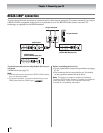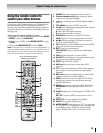
20
Chapter 2: Connecting your TV
Connecting a personal computer
(PC)
With either the PC IN or HDMI connection, you can
watch your computer’s display on the TV and hear the
sound from the TV’s speakers.
To connect a PC to the PC IN terminal on the TV, you
will need:
•Analog RGB (15-pin) computer cable
•PC audio cable
Before using the PC:
See “Using the PC settings feature” (- page 50).
To use a PC:
• Set the monitor output resolution on the PC before
connecting it to the TV.
•Supported signal formats: VGA, SVGA, XGA, WXGA,
SXGA. For detailed signal specifications, see page 88.
Note:
• The PC audio input terminals on the TV are shared with
the HDMI 2 analog audio input terminals.
• Some PC models cannot be connected to this TV.
• An adapter is not needed for computers with a
compatible mini D-sub15-pin terminal.
• Depending on the DVD’s title and the specifications of
the PC on which you are playing the DVD-Video, some
scenes may be skipped or you may not be able to pause
during multi-angle scenes.
Signal names for mini D-sub 15-pin connector
* NC=Not connected
To connect a PC to the HDMI terminal on the TV, you
will need:
If your PC has no HDMI terminal:
•Adapter cable
•Analog audio cable
If your PC has HDMI or DVI terminal:
•HDMI cable or HDMI-to-DVI adapter cable
Supported signal formats: VGA, SVGA, XGA, WXGA,
SXGA, 480i (60Hz), 480p (60Hz), 720p (60Hz), 1080i
(60Hz), 1080p (24Hz/60Hz). For detailed signal
specifications, see page 89.
Note: The edges of the images may be hidden.
TV back panel
PC
PC audio
output
PC audio
cable
Conversion adapter
(if necessary)
Analog
RGB
computer
cable
Pin
No.
Signal
name
Pin
No.
Signal
name
Pin
No.
Signal
name
1 R 6 Ground 11 NC
2 G 7 Ground 12 NC
3B 8Ground13H-sync
4 NC * 9 NC 14 V-sync
5 NC 10 Ground 15 NC
TV upper back panel
PC
PC audio
cable
PC audio
output
HDMI-to-
DVI
adapter
cable


















